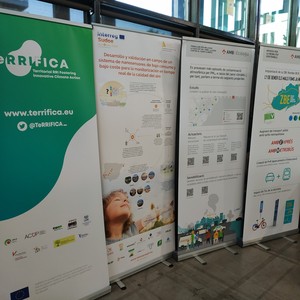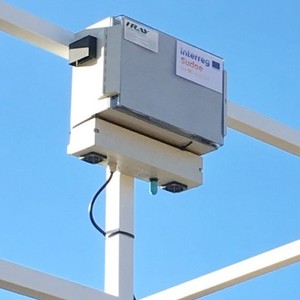The metropolitan strategies for combating climate change, present in several European-level research projects
The AMB is actively involved in the European projects TeRRIFICA and NanoSen-AQM, which focus on combating climate change and developing technology for measuring air quality. The AMB Climate and Energy Plan 2030 provides for measures such as the increased use of renewable energy sources in the region, more natural areas and improved metropolitan facilities.
One of the AMB's strategic objectives is the fight against climate change and air pollution, two of the main environmental problems affecting the metropolitan region. In this regard, it is involved in a number of European research projects focused on developing strategies for mitigating and adapting to these phenomena.
Europe defies climate change
In efforts to mitigate the impact of climate change and adapt to changes that have already taken place or are impossible to prevent, in 2018, the EU published a new long-term strategy for reducing greenhouse gas emissions, in which it set clear priorities for creating a zero-carbon economy by 2050.
In line with this European strategy, the TeRRIFICA (Territorial Responsible Research and Innovation Fostering Innovative Climate Action) project, which was launched in January 2019 and is due to last three years and half, aims to identify and share strategies for implementing climate change adaptation and mitigation activities at local and regional levels. To do so, project partners include both public administrations and a significant number of university institutions, among them the Catalan Association of Public Universities (ACUP).
The TeRRIFICA project is organised around a series of workshops and conferences that bring members and partners together. Several such meetings have already taken place, most recently in Belgrade, Serbia, in July. On that occasion, discussion between the partners helped identify indicators for a successful strategy in the fight against climate change.
The Barcelona Metropolitan Area is one of the pilot regions, along with five other European metropolitan areas and regions. In the case of the metropolis of Barcelona, the results of the project demonstrated the effectiveness of climate change adaptation and mitigation strategies in a densely populated area with a large amount of infrastructure (port, airport, road networks) and which is over 51% green and open space.
As for the AMB, the strategies employed to address these phenomena are set out in its Climate and Energy Plan 2030. This "plan of plans" includes three climate change strategies that the AMB has been using for years: the Carbon Management Strategy, the Energy Transition Roadmap and the Climate Change Adaptation Plan.
Under this umbrella, the AMB has launched numerous projects, such as promoting renewable energy sources throughout the region (with the installation of 480 solar roofs and solar-powered service stations with a view to 2030), improving metropolitan facilities and creating more green areas (parks, rivers and green infrastructure).
Collaborative efforts against climate change
TeRRIFICA has also launched a crowdmapping project, through which the population, by pooling their efforts, can help build a map that highlights the region's main climate threats. The project is based on a voluntary survey, in which participants are asked to indicate two places on the map that they consider significant with regards to certain aspects of climate change: air temperature, water and wind circulation and air and soil quality. The first place must be a good example of activities that have a positive impact on the environment. The second must be a negative example, i.e. areas in the region in which the adverse effects of climate change are already apparent. Participants are also asked to recommend solutions for improving the places regarded as negative. They may add comments or send photographs that illustrate the significance of the place or problem. The hope is to create a map that indicates the actions which both the administrations and population consider a priority in the fight against climate change.
TeRRIFICA crowdmapping
Nanosensors for measuring air quality
The technology for monitoring air quality has a high economic cost, making it difficult to obtain meaningful and reliable real-time data. At present, the administrations use a network of measuring stations that, while they deliver accurate information on the area in their immediate vicinity, fail to cover the whole of the territory.
The NanoSen-AQM project, in which the AMB is involved, is based on developing low-cost gas nanosensors for measuring and providing information about air quality in real time, facilitating massive air quality monitoring.
As air pollution in the Barcelona Metropolitan Area is a major problem, the region will serve as a setting for piloting the new nanosensors developed as part of the NanoSen-AQM project. This technology will be installed on bicycles used by certain courier companies in a number of locations within the AMB. Local campaigns aimed at raising awareness of the air quality in the region of Barcelona will also be conducted, with the installation of information panels and measurements taken from individual sensors, among other measures.
Not only will this increase the number of sensors collecting information about air quality, it will also make the sensors mobile and enable them to cover a larger part of the territory. The objective is to obtain data on air pollutants such as CO, NOx, NO2, O3, PM10 and PM2.5.
At a later stage, the data from all participating regions will be integrated into a cloud-based system managed by the Spanish National Research Council in Madrid.
The first pilot sensors have already been developed and are currently being tested. Once validated, production will commence on the units needed to start the measuring and awareness-raising campaigns sometime in May or June.















































